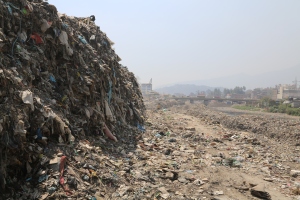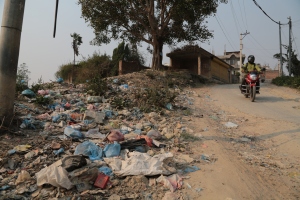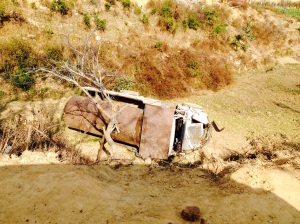There is an allure to the mere word “Nepal.” I first came here in 1983, a single 20-something in search of adventure, which I thought I’d find on the trekking trail. I’d met three tall, muscled Australian guys on the flight to Nepal and one of our most memorable moments together was getting mugged our first evening in Kathmandu. The Aussies managed to catch one of our muggers and at 9p.m., on Kathmandu’s desolate main avenue, a traffic policeman commandeered a passing car and stuffed all four of us in it. He then managed to scrunch the mugger onto my lap for the trip to the central police station. Three decades later Nepal lured me back.
If the news is not about Everest, Nepal does not garner frequent attention from the International media. I get the question all the time: “What is it like to live in Kathmandu?” For me, living in KTM, as many call it, is not about Everest. I am not a climber and though I have Sherpa friends, they are what they call “Kathmandu Sherpas” and many do not even speak their ethnic language. I was raised in a French school that had me reciting the altitude of the Mont Blanc, 4,807 meters, and I am not planning to go above it. This is a potential challenge as Nepal offers 1,500 peaks above 5,000meters. My nine-year-old son is obsessed with Kanchenjunga (#3 highest in the world and by far the most unexplored of the high peaks). So Nepal? Well Nepal is quirky, fascinating, ever changing. I often feel that my everyday is an immersion in history, sociology, live-time economics lessons and human struggle. Never in my 15 years living overseas have I been so overwhelmed, mesmerized, inspired, exhausted and at times confused. I love it because I learn every day.

The Rato Machchendranath chariot, almost ready to be pulled through the streets of Patan ©Donatella Lorch
So let’s just leave Everest aside for a while. What happens on an average week in Nepal? You are always guaranteed a religious festival. The Rato Machchendranath (or Red God) will be on for most of May, a mix of Hinduism and Tantric Buddhism with a hand-made wooden chariot topped by a teetering rope turret and pulled daily by scores of volunteers around the streets of Patan.
The Maosits can’t make up their minds to get along while the Marxist Leninists are having trouble setting a date for a party meeting. Then it’s the economy. Nepal is a land of strikes – called Bandhs or closures – successfully executed by the Maoists for years as they hermetically closed down the country.

Fuel lines snake around the block – a standard sight in Kathmandu where fuel shortages are commonplace © Donatella Lorch
This week street vendors want to block all road traffic in three Nepali cities to protest the new government registration requirement. Fast-onto-death hunger strikes are very common as well protesting police and government corruption and most recently two cement workers went on hunger strike demanding contracts directly from the industry. Miraculously we have diesel and petrol this week as the always-broke Nepal Oil Corporation borrowed from the government to pay the Indians the February oil import bill. But even then, some of the tanker drivers run thriving siphoning off businesses and even the owners of the gas stations tamper with their gauges.
Not paying taxes is becoming a dangerous game for some big businesses. In Kathmandu, the battle is between the administration of Kathmandu Metropolitan City (KMC) and the city’s plush five star hotels. Apparently foreign favorites such as the Hyatt, the Shangri-la, the Yak & Yeti and the Radisson have not been paying their property taxes.
Even worse, they have been ignoring bills from the KMC. Little was known about this on-going battle until the KMC stopped collecting the hotels’ garbage this week. In the stand off, it is unclear where the large amounts of hotel waste is ending up. Everyone’s guess is that it is joining the 60 percent of Kathmandu Valley’s garbage: in open dumping sites such as river banks, road sides and in any empty lot in the city. A great technique for attracting more tourists and more hotel reservations.
Last month, the tax authority closed down a wide range of casinos that had not paid hundreds of thousands of dollars in back-taxes. Not to be outdone, the Nepal Electricity Authority is chasing down defaulting government ministries and threatening to cut their electricity unless they pay back bills. Nepalese are quick to point out that electricity cuts might not be noticed as the valley already has 12 hours of load shedding a day.
Then there is the rain. Bad weather this week had been predicted to last at least six days. Occasional thunderstorms culminated in a storm that stretched into hours of unrelenting torrential rain, whipped left and right by winds while thunder rolled uninterrupted across the mountains circling Kathmandu. Sheet lightning alternated with grand Hollywood style blue bolts zig zagging across the skies. Newspapers reported that 82 people across the country were killed by lightning including one sherpa survivor of the Everest ice avalanche.
In Kathmandu, where many roads have been paved in the past few months in a city-wide road-widening project, it seems the contractors skimped on side ditches and connections to sewage systems. The city flooded. Driving home in close to zero visibility, I could hear the water lapping against the car while mini-rivers made of garbage and plastic bags overflowing from the drainage ditches that double as open sewers, rushed down into the intersections. Always looking on the bright side, the government declared that the rains were good news as now officials could identify before the monsoon hits the locations of the worst flooding.
The sad news is that KTM’s Tribhuvan International Airport removed a collection of Ruslan Vodka advertisements that greeted all arrivals and touted interesting facts about Nepal. “There are 48 airports in Nepal,” read one. The Nepali Times that ran a hilarious photo essay in turn commented: “Only 8 of them have bathrooms.”

































